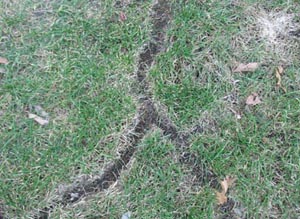Spring is near! 3 quick places to check for critter problems.
- Joe Taylor

- Dec 9, 2021
- 4 min read

The snow is melting and spring is slowly creeping in. The long yawn of winter is finally over. This may be your first chance to take stock of your yard. Let’s hope for no surprises! Now is a good opportunity to walk your yard to gather twigs and branches, pick up winter debris, and perhaps straighten up those flower pots that are knocked over. This is also the perfect time for a quick scan to see if you have any obvious wildlife issues. Let’s cover some basic searches that you can do right now.
1. Checking your lawn
There are two common forms of wildlife that may be evident as the snow melts: voles and moles. Their names are similar, but they are not closely related. While both are mammals, the vole is ordered with the rodents, and the mole is ordered with a group called the Eulipotyphla. This group includes hedgehogs, red-toothed shrews, and the extinct West Indies shrew.
Both the vole and mole can make a mess of your yard. While it is common that people will confuse which critter did the damage, it is fairly easy to make the distinction with a little help. Let’s start with the vole. These creatures spend a lot of time underground and actually were very active during the winter months. They do just fine with a thick layer of snow on the ground. In fact, they love it. Voles will exit their underground burrows and snake across your ground, just beneath the snow. As they run these lines over and over again, they leave very characteristic damage through the grass. This becomes painfully obvious when the snow melts.
The problems do not end with the lawn damage. When your grass, shrubs, and other plants begin to bud, voles will chew at the roots from beneath the ground. Not good!
For voles, look for snaking trails above ground and through the grass. There will be occasional ping pong ball sized holes that lead down and into their burrows.
Let’s talk moles next. Moles do hibernate during the winter. They emerge as the ground temperatures warm and their favored food source, worms, become active. Lawns that are south facing and graded toward the south are most likely to see early mole activity. Moles spend the vast majority of their time underground. The damage they cause is created as they burrow horizontally underground, usually within the first few inches of the ground, pushing a trail of soil overhead. They will also create conical mounds—another prominent indicator.
For moles, look for dirt mounds, and look for trails through the yard where the soil is pushed up. Also, moles repair any holes into their underground runs. If you see a hole going into the run, then there may be more going on than just the mole.
2. Checking your house perimeter
The area immediately around your foundation warrants an inspection. Whether grass runs directly up to the foundation, or you have a border of mulch or rocks, there are vulnerabilities to check. If you have leaves wadded up against the house or under bushes, grab a rake to pull them out. These leaves draw in critters, from insects to mice to rabbits. It is also common to spot vole or mole activity, so use both your eyes and feet to spot and feel for any soft spots. If you have shrubs or trees with branches touching your house, or extending up and over your house, consider trimming these back. Some critters will climb and walk, jump, or drop onto roofs to look for shelter or entry.
3. Checking your deck, porch and shed
Finally, you might have a deck, porch, or shed that provides perfect overhead cover for wildlife. Structures such as sheds will often show an obvious entry point, such as a single hole, leading under the side. The size of the hole will help narrow down what critter has likely gone under.
Want to fill a hole under a shed? Stop! Don’t just fill it, as you could trap an animal beneath and end up with an awful odor. Instead, stuff the hole with some leaves or other debris. Let it set 2-3 days, longer if there is a streak of bad weather. If it gets moved, you know you have an animal coming and going (and who is presently underneath).
The issues for decks and porches is often similar to a shed. The major difference is that decks and porches may have more openings. Sometimes entire sides are wide open. If the number of openings is small, then you could use the leaf-stuffing trick to test for intruders. If your deck or porch is open along greater lengths, then you’ll need to make the call whether you feel there is a concern about wildlife living underneath. Most decks and porches can be made wildlife-proof, but sometimes the process is very involved.
We’ve covered three locations for you to check: your lawn, house perimeter, and places providing overhead protection. Check these areas as soon as the snow melts—especially because some critters were active during the winter and you may still be able to address them and limit their damage. However, plan to walk your yard again during the warm up periods of April and May. Some people are caught off guard when new activity appears during these later months. The sooner you spot the activity, the sooner you can address it to minimize the damage.
Read more about recognizing critter damage in Is there a critter in there?
Joe Taylor, M.S. Science Education, B.S. Biology, is a full time nuisance wildlife control operator in Eastern Iowa, and owner of Paw Control, LLC. Follow him on Twitter: @pawcontroller at LinkedIn, or the Paw Control blog: https://www.pawcontrol.com/blog
Love it? Please share:








Comments